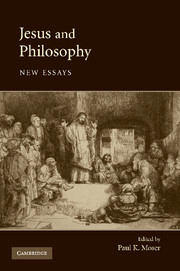Book contents
- Frontmatter
- Contents
- Preface
- Contributors
- Introduction: Jesus and Philosophy
- PART ONE JESUS IN HIS FIRST-CENTURY THOUGHT CONTEXT
- 1 Jesus: Sources and Self-Understanding
- 2 Sipping from the Cup of Wisdom
- 3 The Jesus of the Gospels and Philosophy
- 4 Paul, the Mind of Christ, and Philosophy
- PART TWO JESUS IN MEDIEVAL PHILOSOPHY
- PART THREE JESUS IN CONTEMPORARY PHILOSOPHY
- Index
- References
3 - The Jesus of the Gospels and Philosophy
Published online by Cambridge University Press: 05 June 2012
- Frontmatter
- Contents
- Preface
- Contributors
- Introduction: Jesus and Philosophy
- PART ONE JESUS IN HIS FIRST-CENTURY THOUGHT CONTEXT
- 1 Jesus: Sources and Self-Understanding
- 2 Sipping from the Cup of Wisdom
- 3 The Jesus of the Gospels and Philosophy
- 4 Paul, the Mind of Christ, and Philosophy
- PART TWO JESUS IN MEDIEVAL PHILOSOPHY
- PART THREE JESUS IN CONTEMPORARY PHILOSOPHY
- Index
- References
Summary
This essay considers four ways in which the figure of Jesus as found in the canonical Gospels (Matthew, Mark, Luke, and John) gives rise to the sort of thinking that can properly be called philosophical. I do not want to argue that one way is better than another; each has its merit and each has its limits. I do want to argue that the ways are sufficiently discrete as to demand clarity concerning choices made with respect to the Gospel narratives and how they are being read. I further argue that each approach also carries with it different understandings of what is meant by “philosophy.”
THE HISTORICAL JESUS AS SAGE
The first approach is to consider Jesus not as a character in the Gospel narratives but as a historical figure whose words can be abstracted from those narratives and provide the basis for consideration of Jesus as an ancient Jewish sage. The antecedents of the approach are impressive: the Manichaean teacher Faustus dismissed the Gospel narratives as inventions of the apostles and considered only Jesus's words to be authentic and trustworthy. From Thomas Jefferson to Robert Funk, certain searchers after the “historical Jesus” have also focused on the sayings of Jesus as distinctively providing access to his human identity and mission.
The difficulties of determining the ipsissima verba – or even the ipsissima vox – of Jesus are notorious, as are the diverse motivations of those seeking to discover the “real Jesus” through his speech alone.
- Type
- Chapter
- Information
- Jesus and PhilosophyNew Essays, pp. 63 - 83Publisher: Cambridge University PressPrint publication year: 2008
References
- 1
- Cited by



